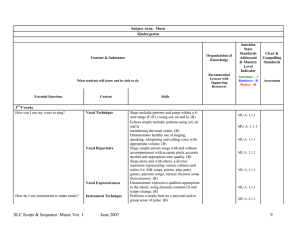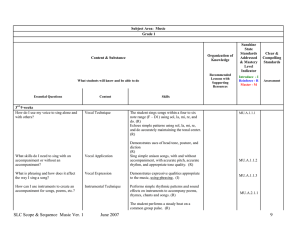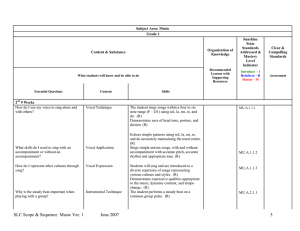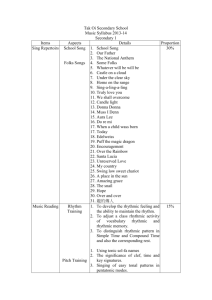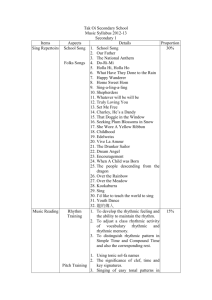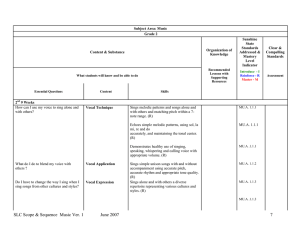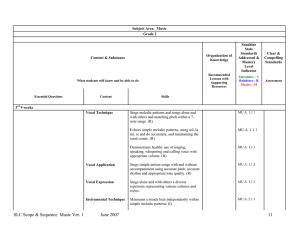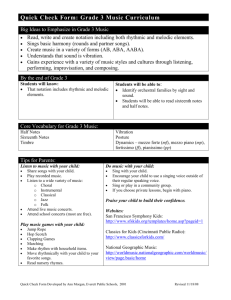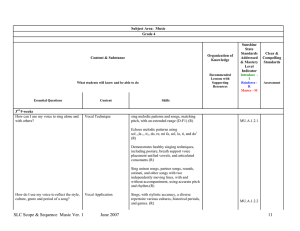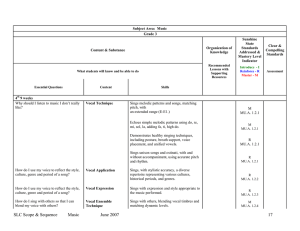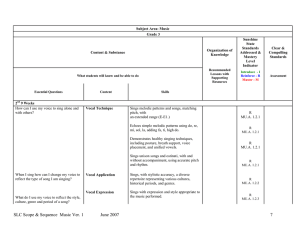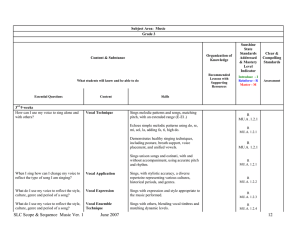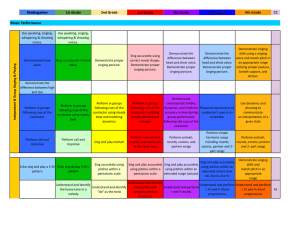Document 11061150
advertisement
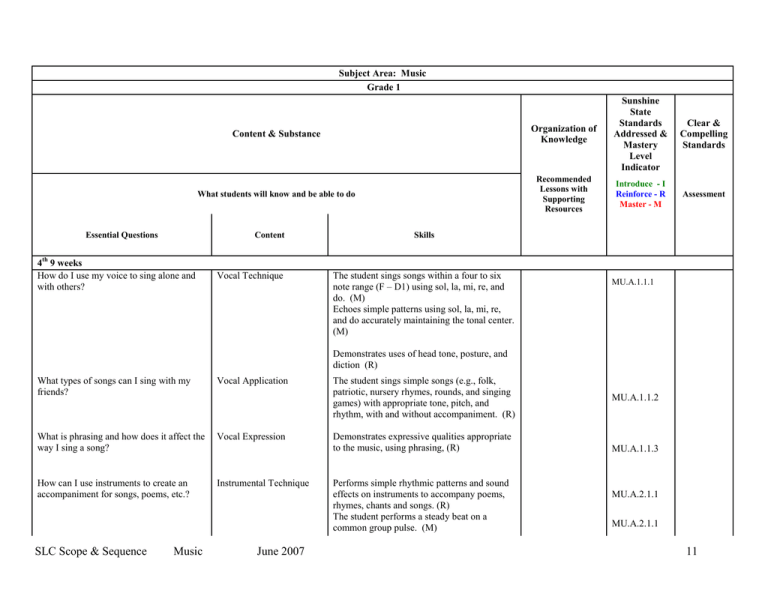
Subject Area: Music Grade 1 Content & Substance Organization of Knowledge Sunshine State Standards Addressed & Mastery Level Indicator What students will know and be able to do Recommended Lessons with Supporting Resources Introduce - I Reinforce - R Master - M Essential Questions Content 4th 9 weeks How do I use my voice to sing alone and with others? Vocal Technique Clear & Compelling Standards Assessment Skills The student sings songs within a four to six note range (F – D1) using sol, la, mi, re, and do. (M) Echoes simple patterns using sol, la, mi, re, and do accurately maintaining the tonal center. (M) MU.A.1.1.1 Demonstrates uses of head tone, posture, and diction (R) What types of songs can I sing with my friends? Vocal Application What is phrasing and how does it affect the way I sing a song? Vocal Expression How can I use instruments to create an accompaniment for songs, poems, etc.? Instrumental Technique SLC Scope & Sequence Music June 2007 The student sings simple songs (e.g., folk, patriotic, nursery rhymes, rounds, and singing games) with appropriate tone, pitch, and rhythm, with and without accompaniment. (R) Demonstrates expressive qualities appropriate to the music, using phrasing, (R) Performs simple rhythmic patterns and sound effects on instruments to accompany poems, rhymes, chants and songs. (R) The student performs a steady beat on a common group pulse. (M) MU.A.1.1.2 MU.A.1.1.3 MU.A.2.1.1 MU.A.2.1.1 11 Subject Area: Music Grade 1 Content & Substance Organization of Knowledge Sunshine State Standards Addressed & Mastery Level Indicator What students will know and be able to do Recommended Lessons with Supporting Resources Introduce - I Reinforce - R Master - M Essential Questions Content Clear & Compelling Standards Assessment Skills 4th 9 weeks When I play an instrument how do I get a good sound out of it? Instrumental Technique How can I change the sound of the instrument I am playing? Instrumental Application How does notation relate to what I play or perform? Notation When I hear rhythmic patterns, can I use notation to write it down? Dictation How can I make my own music? Improvisation Q & A How can I make my body move like the music? Critical Analysis: Movement SLC Scope & Sequence Music June 2007 Performs with appropriate posture and position to produce a characteristic tone quality on nonpitched instruments and pitched instruments. (R) The student will demonstrates expressive qualities of dynamic and tempo, appropriate to the music, while playing classroom and ethnic instruments. (R) Reads and performs simple rhythmic patterns (quarter notes, quarter rest, and two eighth notes) in response to traditional and nontraditional notation. (R) Notates rhythmic patterns (quarter notes, quarter rest, and two eight notes), using manipulatives, that have been performed by someone else. (I) The student improvises a four – beat rhythmic pattern in response to a musical prompt. (R) Responds to selected characteristics of music, including, melodic contour, and same and different patterns, through purposeful MU.A.2.1.1 MU.A.2.1.2 MU.A.3.1.1 MU.A.3.1.3 MU.B.1.1.1 MU.D.1.1.1 12 Subject Area: Music Grade 1 Content & Substance Organization of Knowledge Sunshine State Standards Addressed & Mastery Level Indicator What students will know and be able to do Recommended Lessons with Supporting Resources Introduce - I Reinforce - R Master - M Essential Questions Content Clear & Compelling Standards Assessment Skills 4th 9 weeks movement. (R) ???? When I am at a performance, how should I behave? Critical Analysis: Aural Differentiation Critical Analysis: Vocabulary Application Applications to Life: Daily Life Applications to Life: Audience Etiquette What types of music do I like and why do I like it? Where are the musicians in my school and community and what do they do? Applications to Life: Musical Appreciation Applications to Life: The Role of the musician What words do I use describe the music I hear and perform? How do I use music every day? SLC Scope & Sequence Music June 2007 Identifies selected instruments when presented visually and aurally. (R) Describes specific music characteristics using appropriate vocabulary. (R) Understands the use of music in daily life. (R) Demonstrates appropriate audience behavior in such settings as classroom and school performances. (R) Identifies a personal preference for a specific type of music. (R) Identifies the role of musicians in schools and the community (R) MU.D.1.1.2 MU.D.1.1.3 MU.E.2.1.1 MU.E.2.1.2 MU.E.2.1.3 MU.E.2.1.4 13
